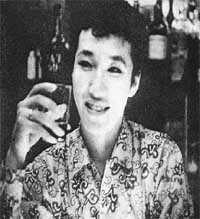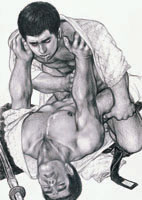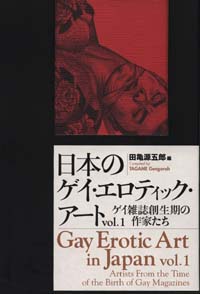-
This beautifully designed and presented collection of gay erotic art is the brainchild of gay Japanese manga artist Tagame Gengoroh whose sadomasochistic fantasy world populated by hypermasculine characters such as policemen and yakuza [Japanese Mafioso] is developing a cult following in Japan and increasingly in the west.
-
Tagame sees himself as part of a long line of artists stretching back to the early 1960s who have struggled to create a characteristically Japanese gay aesthetic. As an aficionado of gay erotic art, Tagame was aware that the work of pioneers of the genre was barely known outside a small clique of collectors in Japan and that there was a grave danger that the bulk of the work created, particularly that of the 1960s, would be lost. In bringing together for the first time a representative sample of pictures created by five artists during the 1960s and 1970s, Tagame's collection highlights the need to record and preserve this body of work and also gives both younger gay men in Japan as well as westerners interested in Japanese popular culture, a new appreciation of the depth and complexity of Japanese gay culture. It is also to be hoped that the book's appearance will stimulate further research into this fascinating period of Japanese history.
-
Featuring Japanese text with a parallel English translation, the collection opens with a discussion of the 'perverse' magazines which first published the work of these artists in the 1960s. This is followed by a representative selection of both black-and-white as well as colour pencil drawings by each artist. A final section discusses each artist's biographical details (to the extent that these are known) and the development of their artistic style. As an artist himself, Tagame's appreciation and respect for the artists he has chosen is evident and his aesthetic eye is able to capture succinctly aspects of each artist's style as well as bring out points of interest in individual illustrations, making the commentaries on each artist particularly valuable.
-
Tagame also provides an historical overview of the development of gay art in Japan, but this is the least successful aspect of the book since he gets into a confusing and largely unnecessary argument over what, exactly, it is about an artist or an art work that makes it a work of 'gay erotic art.' The problem here is that 'gay' or gei in Japanese katakana transliteration is not a term that would have been used as a self-referent by the artists themselves. Tagame tries to side-step the problems of nomenclature by taking a gay essentialist approach, stating that 'homosexuality is an "absolute sexuality which is immanent in an individual"... it is actually part of a person and unchangeable' (p. 11). Following this definition, gay becomes a general descriptive term for those men with an imminent, absolute and unchangeable homosexual inclination irrespective of their cultural or historical context. The search for art which is the product of this imminent sensibility is, however, liable to be contentious and is probably best avoided.
-
For the purposes of this review it is unnecessary to revisit the debate over essentialist and constructivist etiologies of homosexuality other than to note that the extreme essentialist position adopted by Tagame is almost impossible to support in the face of historical and cross-cultural diversity. For instance, in the Japanese context, an investigation of Japan's postwar sexual culture reveals a complex, hybrid system of interlocking discourses, representations and identities which make it impossible to plot the development of a nascent 'gay identity' although there are clearly elements in this mixture that can be appropriated by contemporary gay people in pursuit of a community history. Whether or not the artists themselves would have recognized themselves as part of this project, however, remains a moot point.
-
Homosexuality was a much more visible feature of Japan's postwar culture than it was in Anglophone societies but it is difficult to give a satisfactory account of this period using contemporary models of gay identity. While the 1950s in the US and elsewhere saw the return to more restrictive models of sex and gender behavior, after the war, the Allied Occupation in Japan removed many of the restrictions on publishing that had stifled the press in Japan during its fifteen years of militarism. Concerned more with monitoring political than sexual discussion, the new administration made it possible for a new kind of publication to emerge in Japan in which 'perverse' sexuality could be represented outside of the pathologising framework that had limited its expression before the war and which still constrained discussion of homosexuality in the English press.
-
From the early 1950s, a range of magazines appeared in Japanese that allowed readers to indulge their interest in sexual perversity and often it was those considered perverse and not medical or other 'experts', who were able to speak. These publications had an extremely wide range of interests and, purporting to offer true accounts, drew upon anecdotes from Japan's feudal past as well as stories from European and Asian societies, often relying on anthropological reports. Significantly, these early magazines did not segregate the material into hetero- or homosexual-themed issues, as became increasingly common in the 1970s, but presented a wide range of 'perverse desires' [hentai seiyoku].
-
The most long lived was Kitan kurabu [Strange-talk club] published between 1950 and 1975 which, albeit mainly focusing on SM, included discussions and illustrations of a range of 'queer' [katayaburi] topics including homosexuality and male and female cross-dressing.
 Fûzoku kitan, one of the most long-lived of the 'perverse' magazines
published from 1960-1974.
Fûzoku kitan, one of the most long-lived of the 'perverse' magazines
published from 1960-1974.
|
Other magazines which included information about homosexual and transgender phenomena included Fûzoku kagaku [Sex-customs science] (1953-55), Fûzoku zôshi [Sex-customs storybook] (1953-4) and Ura mado [Rear window] (1957-65). While all these magazines featured articles and illustrations relating to male homosexuality, as Tagame points out, it was Fûzoku kitan [Strange talk about the sex world] (1960-1974) which showed the strongest interest in this topic and which featured the homosexual erotic art work of four of the artists introduced in Tagame's collection—Okawa Tatsuji, Funayama Sanshi, Mishima Go and Hirano Go.
|
-
However, given the nature of publications such as Fûzoku kitan which focused on a wide range of perverse desires, with a particular emphasis on sadomasochism, the use of the
 This illustration by Oda Toshimi in Fuzoku Kitan is an example of the ?perverse? nature of these early magazines, mixing sadomasochism, voyeurism and homoeroticism in the one image.
This illustration by Oda Toshimi in Fuzoku Kitan is an example of the ?perverse? nature of these early magazines, mixing sadomasochism, voyeurism and homoeroticism in the one image.
|
term 'gay' to describe these images seems anachronistic in this context, especially given the violent and sadomasochistic contexts in which the artists placed their figures. The problem with the term gay or gei in katakana transliteration is that it was already in wide use in Japanese in the 1950s but it had a meaning quite different from the English term which was gradually emerging in the US as the most widespread designation for members of the homosexual subculture.
|
-
The indigenisation in Japan of the term 'gay' is an interesting example of cross-cultural borrowing. By the end of the war, 'gay' had established itself as a common referent among homosexual men and women all over the US since the mass mobilization of US forces, bringing homosexuals together from all parts of the country, standardized gay slang. Gay [gei] subsequently entered Japanese via homosexuals in the Occupation Forces. Mishima Yukio mentions the term 'gay' (in Roman letters) in his 1952 novel Kinjiki [Forbidden Colours] where he glosses it as 'American slang for danshokuka'—the latter term being a neologism made up of the traditional term for male love nan/danshoku and the nominalising suffix 'ka' or 'ist'. However, the fact that he has to gloss the term suggests that it was not widely understood at this time.
-
Yet, by the late 50s gei, especially as part of the compound gei bôi, was frequently used in the Japanese media to describe effeminate homosexual men, and was used as the title of Tomida Eizô's 1958 book, Gei, where he described gei bôi as 'more feminine
 Picture of a gei bôi from Tomita Eizô (1958), Gei, Tokyo: Tôkyô shobô.
Picture of a gei bôi from Tomita Eizô (1958), Gei, Tokyo: Tôkyô shobô.
|
than today's boyish young women.'[1] The widespread use of the term gei in Japanese therefore predates the use of 'gay' in English which did not become a common referent for homosexuals (outside of specific subcultures) until the early 1970s. Another reason that gei bôi was so quickly popularized in Japan is that gei (written in the katakana syllables used to transcribe foreign loanwords) is a homophone for gei (written with the character for 'artistic accomplishment'—as in geisha) and gay boys were sometimes spoken of as gei wo uri, that is 'selling gei.' In this phrase gei designates not sexual orientation but a kind of artistic performance—female impersonation.
|
-
Since gei had such strong transgender connotations, it was not used in the immediate postwar period as a site of identity for masculine-identified men who liked other masculine men—instead homo (a contraction of homosekushyaru) was the most common referent for such men. From the 1960s, the term homo bā, as opposed to gei bâ , was used to designate bars that catered exclusively to homosexual men and homo came to designate men with homosexual tastes but who were otherwise gender-normative. Indeed, even today, it is possible to find bar owners in Japan who insist that their establishments be designated homo bâ because the term 'gay bar' still conjures up images of cross-dressing.
-
Yet, even homo was not much used as a site of identification. Instead, in the immediate postwar period, men interested in sexual interaction with other men tended to refer to each other in terms of sexual 'type'— that is, sexual identity, such as it existed, revolved around sexual roles, much as it had done in the prewar period. In the argot of the time these types included tachi or tops, onê from onesan or big sister) for effeminate men, donten or 'reversible' boys who serviced both men and women, chigoka[2] or older men interested in youths, jibika[3] who preferred older partners and ritsu[4] or 'gold diggers' who were in search of a sponsor.
-
Hence, the cultural context in which these early 'gay' artists were working was extremely complex and quite different from the nascent gay communities in places such as New York or San Francisco. The magazines in which they published were not directed at a distinct homosexual readership but offered information about a wide range of 'perverse' sexuality—with a strong emphasis on sadomasochism. Also, the homosexual world itself was split between masculine and transgender models wherein an individual's 'identity' relied more upon his preferred role as opposed to an imminent sensibility.
-
However, with these provisos in mind, the artists featured in Gay Erotic Art do mark an important break with the past and it is possible to discern a convergence with changes that were also taking place in the Anglophone homosexual world. For the first time we see the depiction of adult masculine, or rather hypermasculine, figures as objects of desire for other men. The previous tradition of shunga (erotic woodblock prints) had represented the youthful, feminine figure of the boy as an object of aesthetic appreciation, not his adult lover, a trend which carried over into the modern period in the work of Takabatake Kashô whose homoerotic illustrations of young boys were popular in the 1920s. In the perverse magazines of the 1950s and 60s, however, we see a trend toward the increasing representation of sexual interaction between men who are equally adult and equally masculine—a relationship which has been referred to as 'egalitarian homosexuality'—quite distinct from the 'transgenerational' and 'transgender' paradigms of homosexual interaction that are typical of premodern societies.
 Mishima Go (p. 26)
Mishima Go (p. 26)
|
 Hirano Go (p. 126)
Hirano Go (p. 126)
|
-
The figures depicted in Fûzoku kitan— policemen, yakuza, laborers and bath-house attendants are the Japanese equivalents of American fantasy types—sailors, bikers, cowboys, lumberjacks—developed in the art of George Quaintance and Tom of Finland whose illustrations had been popular since the late 1950s in US proto-gay publications such as Physique Pictorial. Tom of Finland's work is illustrative of the changes that were taking place in US and European gay subcultures at this time in which the previous emphasis on youth as an object of desire was being displaced by representations of heightened masculinity. Fûzoku kitan's choice of a very 'masculine' style of homosexual imagery is further evidence of the retreat from 'traditional' transgender and transgenerational patterns of homosexual interaction toward more masculine modes of homosexual identity and experience which was also taking place in Japan during this period—independently, it would seem, from changes taking place in the US. However, while the artworks in the collection evince the same trend away from feminine toward more masculine and hypermasculine representations of homosexuality, what is specific to the Japanese genre is the sadomasochistic setting of many of the illustrations and the extraordinary extent to which some pictures are imbricated with violence and death. Indeed, violence, sadism and masochism have remained constant themes in Japanese gay art and are developed to an extreme in the art of Tagame himself. Quite how this sadomasochistic subtext relates to a supposedly imminent gay identity, however, remains unexplored.
 Okawa Tatsuji (p. 63)
Okawa Tatsuji (p. 63)
|
 Funayama Sanshi (p. 92)
Funayama Sanshi (p. 92)
|
-
The change in the paradigm of homosexual identity is further discernable in several privately produced 'homophile' magazines mentioned by Tagame which were in circulation in Japan during the 1950s and 60s and which also reproduced works by these artists. The Adonis Kai or Adonis Organization had been founded as early as 1952 and published an in-house magazine for its members entitled Adonis. This modest magazine, usually running to a little over forty pages, was published from 1952 until 1962, totaling 63 issues in all. In 1963 Bara [Rose], a simple paper-bound magazine running from 42 to 58 pages appeared. Like Adonis, it was available by subscription only—in order to receive copies, subscribers had to send a fee directly to the publisher. Bara's contents were largely similar to those of Adonis, including discussion articles, erotic stories and photographs and illustrations. Unlike the perverse magazines, Adonis and Bara were not available from booksellers (although some copies ended up in second-hand stores) and could only be subscribed to, this meant that they had extremely limited circulations. However, they did provide a training ground for writers and artists who were to contribute to the first commercial homosexual magazines of the early 1970s.
-
It was in these magazines— Barazoku, first published in 1971 and Sabu in 1974 that 'gay erotic art' emerged as a distinct genre since, as well as reproducing illustrations in each monthly issue, the magazines also brought out special picture editions which created a greater market and thereby encouraged more artists to begin creating art tailored to this market.
-
Tagame himself acknowledges in the introduction that he is an artist and not a scholar of sexuality and it is in the illustrations that he has brought together (over 140 full page reproductions) that the great interest of this collection lies. Indeed, practically no academic work exists in either Japanese or English which focuses on the early postwar perverse magazines, the development in the 1960s of privately circulated homophile magazines and the transition to the commercial homosexual magazines of the early 1970s. In bringing together so many illustrations by artists from different periods and publications, it is possible to get some sense of the important changes that were taking place in Japanese concepts of homosexuality in the postwar period. It is to be hoped that through releasing this collection of pictures and drawing attention to the milieu in which the artists worked, Tagame's volume will encourage other researchers to take the topic of homosexual representation in Japanese art more seriously. Yet, while this collection is a first and invaluable step toward reconstructing a history of Japanese homosexual community and identity formation in the postwar period, much still remains to be done.[5]
Endnotes
[1] Tomida Eizô (1958), Gei, Tokyo: Tôkyô shobô, p. 181.
[2] Chigo is a term deriving from the Edo Period (1600-1857) nanshoku code of male-male eroticism. It originally designated a young temple acolyte but came to be used to refer the younger partner in a transgenerational homosexual relationship. Ka here is a suffix meaning 'specialist'.
[3] Jibika here is made up of the characters for ear and nose as in the medical 'ear, nose and throat specialist'. Perhaps an ironic reference to the fact that older men were sometimes hard of hearing. Another term was fukesen or 'specialists in older men'.
[4] Ritsu means a rate or percentage.
[5] The most valuable Japanese source for this period is Fushimi Noriaki's Gei to iu keiken [The experienced called gay], Tokyo: Potto shuppan, 2003. My own book
Kono Sekai: Queer Japan from the Pacific War to the Internet Age (in press) is, to my knowledge, the only treatment in English of homosexual identity and practice in the immediate postwar period in Japan.

|

